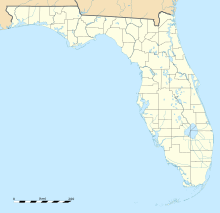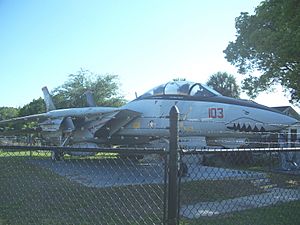Naval Air Station DeLand facts for kids
Quick facts for kids
Naval Air Station DeLand
|
|
|---|---|
| Summary | |
| Airport type | Military: Naval Air Station |
| Operator | United States Navy |
| Location | DeLand, Florida |
| Built | 1942 |
| In use | 1942–1946 |
| Occupants | United States Navy |
| Elevation AMSL | 70 ft / 21 m |
| Coordinates | 29°03′59″N 81°17′02″W / 29.06639°N 81.28389°W |
| Map | |
Naval Air Station DeLand was a military airport in DeLand, Florida. It was used by the United States Navy from 1942 to 1946. After World War II, this airfield became the DeLand Municipal Airport, which is still in use today.
Contents
History of the Air Station
The city of DeLand started building a civilian airport in the 1920s. The first paved runway was ready around 1936.
In 1942, during World War II, the city gave the airport to the United States Navy. It was officially renamed Naval Air Station DeLand on November 17. The airfield opened after the Navy bought more land and built many military buildings. Captain Tom Turner, the first commanding officer, led the opening ceremony. The DeLand High School band played music because the air station did not have its own band yet.
Aircraft Training and Operations
NAS DeLand's main job was to provide advanced training for Navy flight crews. They learned to fly different types of patrol bombers and dive bombers. These included the Lockheed PBO-1 Hudson, Lockheed PV-1 Ventura, and Consolidated PB4Y-2 Privateer patrol bombers. They also trained on carrier-based Douglas SBD Dauntless dive bombers.
The first planes to arrive were the Hudsons. These planes had been used by Patrol Squadron 82 (VP-82) for training in other locations. VP-82 was known for sinking the German submarine U-656, which was the first U-boat sunk by U.S. forces in World War II. These Hudsons helped train pilots for the PV-1 Ventura planes at NAS DeLand and nearby Naval Air Station Sanford. Training for the PB4Y-2 Privateer planes began in 1943.
Many of the U.S. Navy's current maritime patrol squadrons, which fly planes like the Lockheed P-3 Orion and Boeing P-8 Poseidon, can trace their history back to squadrons that started at NAS DeLand during World War II.
When the SBD Dauntless dive bombers arrived, along with their pilots and crew, the Ventura training was reduced.
Samuel Hynes, who later became a professor at Yale University, was a Marine pilot during World War II. He learned to fly Dauntless dive bombers at DeLand. He said that the planes were old and had been used in combat. Their instructors were also combat veterans who had fought in the Pacific. They taught the pilots how to dive a plane straight down and drop a bomb while diving. This was a very difficult and unnatural thing to do.
In 1944, training for the Grumman F6F Hellcat carrier-based fighter also began at NAS DeLand. An advanced navigation school for new pilots was also started.
Many people from DeLand worked at the base in support roles. They were paid much better wages than they had seen during the Great Depression.
Military Training Sites

Nine Mile Point on Lake George was controlled by NAS DeLand. It was used as a practice bombing site. A Navy Consolidated PBY Catalina seaplane was kept nearby in case of an aircraft accident on the lake. This Lake George site is still used today as part of the Navy's Pinecastle Electronic Warfare and Bombing Range in the Ocala National Forest. This range is managed by NAS Jacksonville. NAS DeLand also had two sailors who patrolled Lake Woodruff to help if any naval aircraft had problems nearby.
NAS DeLand was also responsible for other facilities. These included Navy Outlying Field New Smyrna Beach and bombing targets near Paisley, Hawkinsville, the Indian River Lagoon, and east of Lake Dias near DeLeon Springs. Planes from Naval Air Station Daytona Beach and NAS Sanford also used these sites.
The airfield at New Smyrna Beach was used to refuel and rearm aircraft. These planes practiced landings at Outlying Field Spruce Creek and practiced target shooting over the Atlantic Ocean. Sometimes, these planes carried 500-pound bombs when they were over the ocean. This was in case they spotted any German U-boats.
Decommissioning of the Base
After World War II ended, the base closed as an active naval installation on March 15, 1946. Its control tower also closed. The city of DeLand got the air station back. It then became the DeLand Municipal Airport, which it remains today.
Stetson University College of Law
From 1946 to 1953, the former base was also home to Stetson University College of Law. The law school moved to Gulfport, Florida, in 1954.
The DeLand Naval Air Station Museum is located in the historic Chief Master at Arms House in DeLand, Florida. It was opened in 1995. The museum focuses on the history of Naval Air Station DeLand, U.S. Naval Aviation, and United States Navy history.
Exhibits at the museum include:
- An F-14 Tomcat fighter jet, on loan from the National Naval Aviation Museum.
- PTF-3, a former USN Nasty class torpedo boat that is being restored.
- A Grumman TBF Avenger torpedo bomber that is also being restored.
- A Korean War era H-13 Sioux MASH helicopter.
- A 1954 U.S. Army M38A1 jeep.
- Various military artifacts.
- Old photographs.
- Other items related to the base's history.



